When your AC stops cooling during Tulsa’s scorching summer heat, every minute without relief feels like an eternity. That’s exactly what one local homeowner experienced when they called us about their malfunctioning air conditioning system. What started as a simple service call for an AC not cooling in Tulsa, Oklahoma, quickly revealed a more serious issue that required immediate attention.
The customer’s frustration was understandable – with temperatures soaring into the 90s and beyond, a non-functioning air conditioner isn’t just an inconvenience; it’s a genuine emergency. Upon receiving their call, we immediately dispatched our experienced technician Caleb to diagnose the problem and provide a solution. What he discovered during his inspection would ultimately lead to a complete system upgrade that transformed the home’s comfort and energy efficiency.
The initial diagnosis revealed a significant freon leak in the existing unit, a problem that goes far beyond a simple repair. This case study demonstrates why sometimes the most cost-effective solution for a failing AC system is a complete replacement, especially when dealing with older, less efficient equipment in Oklahoma’s demanding climate.
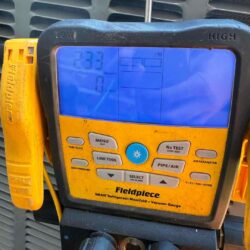
Why Your AC Might Stop Cooling in Tulsa’s Climate
Tulsa’s unique climate presents specific challenges that can cause air conditioning systems to fail unexpectedly. With summer temperatures regularly climbing above 95°F and humidity levels that make your Air conditioner have to work harder. This constant strain accelerates wear and tear on critical components, leading to premature failures and reduced cooling capacity.
Several factors commonly contribute to AC systems losing their cooling ability in the Tulsa area. Refrigerant leaks, like the one discovered in our customer’s system, are among the most serious issues. When freon escapes from the system, the AC cannot properly absorb heat from your home’s air, resulting in warm air blowing from your vents despite the unit running continuously. Other frequent culprits include dirty evaporator coils, failed compressors, clogged air filters, and electrical component failures – all problems exacerbated by Oklahoma’s harsh summer conditions.
The decision between repairing and replacing an AC system becomes critical when dealing with major issues like refrigerant leaks. While small leaks might seem repairable, older systems often have multiple weak points that will continue failing. In Tulsa’s demanding climate, investing in a newer, more efficient system typically provides better long-term value than repeatedly patching an aging unit that’s struggling to keep up with cooling demands.
Professional AC Diagnosis: Finding the Root Problem
When Caleb arrived at the customer’s home, he began with a comprehensive system inspection that would determine the best course of action for their AC not cooling properly. His methodical approach started with checking the obvious culprits – air filters, thermostat settings, and electrical connections – before moving to more complex diagnostic procedures. This thorough evaluation process is crucial for Tulsa homeowners because misdiagnosing the problem can lead to unnecessary repairs and continued discomfort.
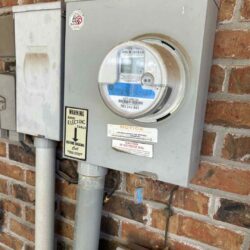
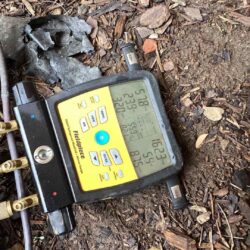
The inspection quickly revealed the source of the cooling problem: a significant freon leak in the existing system. Using specialized leak detection equipment, Caleb pinpointed multiple areas where refrigerant was escaping, indicating that the system had developed several weak points over time. This type of extensive leakage typically occurs in older units where seals, joints, and coils have deteriorated due to years of expansion and contraction cycles common in Oklahoma’s variable climate.
Based on his findings, Caleb recommended complete system replacement rather than attempting repairs. While it might seem more economical to simply fix the leaks and recharge the system, this approach would likely result in recurring problems and higher long-term costs. The age of the existing equipment, combined with the extent of the refrigerant leaks, made replacement the most practical solution. This recommendation would soon prove wise when project managers conducted their own assessment and confirmed that a new high-efficiency system would provide superior performance and reliability for years to come.
The High-Efficiency Solution
After confirming Caleb’s assessment, our project managers recommended a significant upgrade to a 14.3 SEER2 air conditioning system paired with a single-stage furnace. This recommendation wasn’t just about replacing the broken unit – it was about providing the Tulsa homeowner with a complete comfort solution that would perform reliably in Oklahoma’s challenging climate while reducing energy costs year-round.
The 14.3 SEER2 rating represents a substantial improvement in energy efficiency compared to older systems commonly found in Tulsa homes. SEER2 is the updated seasonal energy efficiency ratio that more accurately reflects real-world operating conditions, and a 14.3 rating means this system uses significantly less electricity to produce the same cooling output as older units. For homeowners dealing with Oklahoma’s extended cooling seasons, this translates to meaningful savings on monthly utility bills while maintaining superior comfort levels.
The single-stage furnace component of this system provides reliable heating performance during Tulsa’s winter months, creating a complete year-round HVAC solution. Unlike the customer’s previous aging equipment, this new system is designed to handle the extreme temperature swings common in Oklahoma – from scorching summers that can exceed 100°F to winter lows that may drop below freezing. The combination of high-efficiency cooling and dependable heating ensures consistent indoor comfort regardless of outdoor conditions, giving the homeowner peace of mind that their AC not cooling problems are permanently resolved.
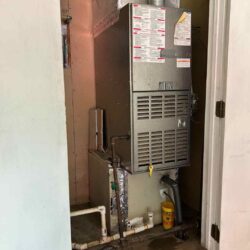
The installation process began with the removal of the existing system to make way for the new high-efficiency equipment. Our team located both the indoor furnace and outdoor condenser unit, ensuring all electrical connections were properly disconnected before beginning the removal process. This systematic approach to AC change outs is crucial for AC replacement projects in Tulsa, as it allows technicians to identify any underlying issues with ductwork, electrical systems, or installation methods that could affect the new system’s performance.
Once the old equipment was removed, the real work began with installing the new outdoor condenser unit. The team established a proper foundation by installing a new equipment pad, ensuring the condenser would have stable, level support for years of reliable operation. They also installed a new electrical disconnect and whip, bringing the electrical connections up to current code standards – an important safety consideration for Oklahoma homeowners. The condenser was carefully positioned and connected to pump-up equipment to facilitate the initial system setup.
The indoor installation proved equally thorough, with the new furnace and evaporator coil being precisely positioned and connected. Our technicians meticulously taped and sealed all gaps in the ductwork connections, ensuring optimal airflow and preventing energy losses that could compromise the system’s efficiency. They also upgraded the gas line connections to current code standards, including the installation of a proper drip leg for safety compliance. Additionally, a clean-out was added to the condensate drain line, making future maintenance easier and helping prevent water damage issues common in humid climates like Tulsa’s.
Testing and System Optimization
The final phase of the installation included upgrading the home’s temperature control with a new Honeywell T6 thermostat, providing the homeowners with precise climate control and programmable features. This advanced thermostat allows for better energy management, particularly important during Tulsa’s extended cooling seasons when AC systems run for months without interruption. The digital controls also provide diagnostic capabilities that can alert homeowners to potential issues before they become major problems.
System testing revealed exactly what the customers had been hoping for – both heating and cooling functions performed flawlessly. Our technicians conducted comprehensive operational tests, verifying proper airflow, temperature differential, electrical draw, and refrigerant pressures throughout the system. The successful test firing confirmed that this Tulsa home’s AC not cooling problems were completely resolved, with the new high-efficiency system ready to provide reliable comfort for years to come. The system was declared fully operational, giving the homeowners confidence that their investment would deliver consistent performance even during Oklahoma’s most demanding weather conditions.
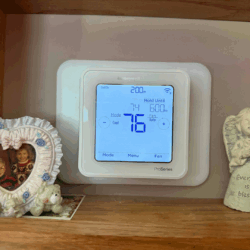
If your AC stops cooling in Tulsa, Oklahoma, quick professional diagnosis is essential to determine whether repair or replacement offers the best value.
Professional installation makes all the difference in system performance and longevity. From achieving proper vacuum levels to ensuring code-compliant electrical and gas connections, every detail matters when replacing HVAC equipment. The comprehensive approach taken in this project – including ductwork sealing, drain line improvements, and advanced thermostat installation – creates a complete comfort solution designed to handle the unique challenges of Oklahoma’s climate.
Don’t let AC problems leave you uncomfortable during Tulsa’s hottest days. If your air conditioning system isn’t cooling properly, contact our experienced team for a thorough diagnosis and honest recommendations. Whether you need emergency repairs or are considering a high-efficiency system upgrade, we provide the expertise and quality workmanship that Tulsa homeowners trust. Call us today to schedule your AC inspection and take the first step toward reliable, efficient home comfort that will keep you cool all summer long.

